Rabie Abdel-Halim
Riyadh, Saudi Arabia
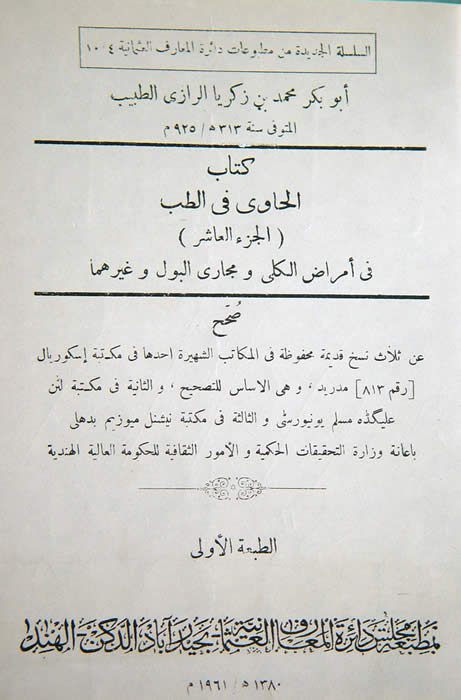
Although lithotripsy1 is often looked on as a modern discovery, its roots may be traced back to antiquity. Yet there is little mention of lithotripsy in Greek medical writings, perhaps because of Hippocrates’s injunction to avoid cutting for the stone2 (Cumston, 1968). This silence lasted for several centuries (Dimopoulos, Gialas, Likourinas, Androutsos, & Kostakopoulus, 1980) and it was not until 50 A.D. that Celsus described the technique of Ammonius3 (200 B.C.) for splitting a large bladder stone through a perineal cystotomy by using a scoop, chisel and hammer (Celsus, 1938), now considered the earliest trial for crushing a stone.
Even though Celsus had long recommended the procedure (Celsus, 1938), it was not popularly employed because Charaka,4 Antyllus,5 and Susruta6 advised against breaking a bladder stone or even scratching it up till the fourth century (Charaka, 1961; Antyllus, 1961; Susruta, 1972). The idea was not even mentioned by Paulus Aegineta, the Byzantine physician who in the seventh century was thought to have summed up all medical knowledge of his time (Aegineta, 1846). Moreover, from the ninth to the fourteenth century the age of Greco-Roman medicine in Europe was coming to an end and there was no further progress in terms of lithotripsy (Cumston, 1968; Margotta, 1968; Bickers, 1969; Desnos, 1972).

In the East, however, the study of medicine and other branches of science were revived with the establishment of Islam, which strengthened scientific inquiry7 (Cumston, 1968; Dickinson, 1975; Kirkup, 1981). In accordance with this, Al-Razi8(Rhazes) (841-926 A.D.) described a new technique for breaking a large stone in the tenth volume of his twenty-three volume book, Al-Hawi Fi Al-Tibb (The Liber Continens), which represents his principal contribution to medicine (Fig. 1) (Al-Razi, 1961). He used a strong pincer (Fig.2) to hold firmly onto a part of the stone made to protrude through a perineal cystotomy and break it away. The process was repeated at different angles until the stone was small enough to come out. This technique was an advance on classical procedures and a landmark in the process of stone crushing (Adams, 1846).

for crushing large vesical stones through a perineal cystotomy.
Later Al-Zahrawi (Albucasis)9 (930-1013 A.D.) carried Al-Razi’s original idea further by designing a special forceps al-kalalib10 with which he could grasp the stone firmly through a perineal cystotomy and, with manual compression, break it into fragments (Fig. 3) (Albucasis, 1973). This has been described as the primitive lithotrite11 (Kirkup, 1981).
For managing an impacted urethral stone, Al-Zahrawi designed a fine drill (which he named al-mishaab12), which revolved gently upon the stone, perforating it until it was pierced through; the penis was then squeezed from outside by the other hand so that the broken remnants of the stone crumble and could be eliminated in the urine (Fig. 4). This device is generally viewed as representative of the foundation of true lithotripsy (Cumston, 1968; Spink & Lewis, 1973; El-Faquih & Wallace, 1978). Clearly, Al-Zahrawi was not just a mere compiler of ideas but rather a skillful surgeon who integrated surgery into scientific medicine (Cumst on, 1968; Desnos, 1972; Spink & Lewis, 1973; Campbell, 1974; Ullmann, 1978; Montagnani, 1986); his thirty-volume book, Al-Tasrif, was translated to Latin and came to greatly influence the European schools of medicine from the medieval period well into the eighteenth century (Fig. 5).
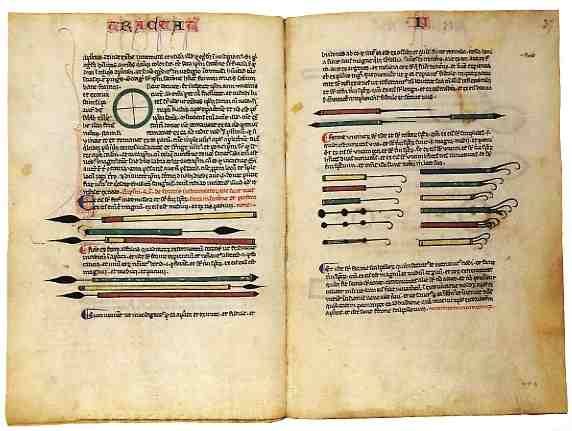
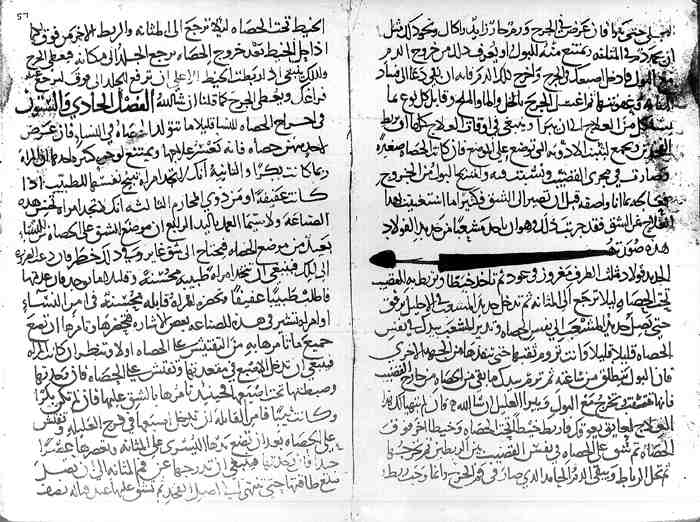
In Europe, the nineteenth century opened a period of ingenuity on the part of surgeons and surgical instrument makers (Ellis, 1969). Therefore, by the notion of getting at the stone while in the bladder, Al-Zahrawi’s idea of drilling by al Mishaab which was introduced transurethrally to the bladder along a metal canula constituted the foundation of the Litholepte of Fournier de Lempdes13(1812), the instrument of Gruithuisen14 (1813), Civiale’s15 trilabe (1818), Leroy d’Etoilles’16 curved trilabe (1827) and the Brise Coque of Rigal de Jaillac (1829) (Fig. 6). They differed only in their mode of stone fixation. Eventually, Al-Zahrawi’s idea of drilling was modified by replacing al mishaab by a rotating burr, as in Leroy d’Etoilles’ Lithoprione (1822) and Civiale’s Lithontripteur (1823).
Al-Zahrawi’s model of lithotripsy was then taken further. The lithotrite, introduced by Andreas a Cruce in the early eighteenth century, was in fact a modification of Al-
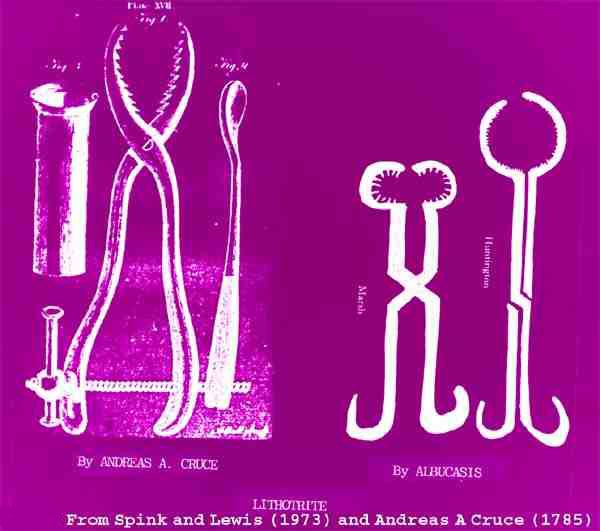
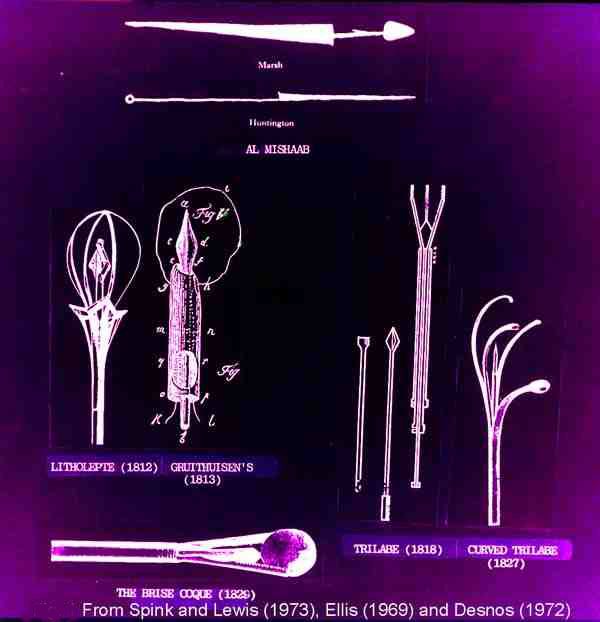
Zahrawi’s lithotrite, in which the manual compression on the handle was replaced by a screw action (Fig. 7) (a Cruce, 1785). In 1822, Amussat17 developed the idea further by applying it transurethrally instead of through a perineal cystotomy.
By 1832, the jointed serrated blades that Al-Zahrawi had devised to crush the stone were replaced by parallel blades, first advocated by Heurteloup18 in his percussion lithotrite. The percussion was then replaced by a successful screw action in 1834. Further efforts were aimed at identifying the most efficient evacuation of fragments, and by 1878, lithotripsy was recognized as a valuable and safe surgical operation. As Maximilien Littré19 pointed out, “There is nothing in the most advanced contemporary medicine whose embryo cannot be found in the medicine of the past” (Littré, 2001).
Notes
- Up until the seventeenth century, cutting for the bladder stone (cystolithotomy) was always done via a small, but deep incision in the perineum (perineal cystotomy). The dangers and complications of this anatomically difficult approach were more severe with the large stones. Lithotripsy (also known as lithotrity) was, therefore, originally designed as a procedure to make the removal of a large stone easier and less dangerous by crushing it into small pieces within the bladder.
- Hippocrates, the father of medicine (born in 460 B.C. in the Island of Cos) regarded wounds in the urinary bladder as fatal. Based on this concept, the Hippocratic oath contained an injunction forbidding the operation of cutting for bladder stone. Interestingly this operation through perineal cystotomy was practiced in ancient India from very early times.
- Very little is known about Ammonius. This quotation by Celsus is the only available extant source about him. Considered by Celsus as the originator of the technique of crushing a bladder stone before removing it, Ammonius was given the surname of Lithotomus. He is also known as Ammonius of Alexandria (Egypt) where he lived in the 3rd century BC. Care should be taken not to mix him up with the two well-known Alexandrian school philosophers Ammonius Saccas (3rd century AD) and Ammonius Hermiae (5th century AD) as both of them were also called Ammonius of Alexandria.
- Charaka (also written as Caraka), Susruta, and Vaghbata are the three greatest names to emerge from height of Hindu Medicine. While there is unanimity regarding their eminence there is little regarding the dates of their activities. However it is generally accepted that Charaka flourished in the second century AD. His work Charaka Samhita or the Charaka Compendium is one of the classics of Hindu Medicine. It is a revision of the work of Atreya, Agnivesa, and other ancient famous Indian authors. It is now held in high esteem as the most authentic of all the extant works on the Ayurevedic system of medicine. It was translated from Sanskrit to Persian and from Persian to Arabic in the beginning of the eighth century AD.
- Antyllus was a 2nd century AD Greek medical scholar who surpassed Galen in the field of surgery. He added original contributions to the technique of cutting for the stone and also to several other areas of surgical practice.
- Susruta (also written as Sushruta), the greatest surgeon of ancient India lived sometime in 400 BC. Athough there is still some controversy about this date, it is certain that he devoted himself to surgery and taught the subject to his pupils. His famous writings known as Sushruta Samhita are devoted mainly to surgery but also contained other medical subjects. The operation for the removal of bladder stones was well described in Sushruta Samhita, which also contained notable contributions in plastic surgery, most notably nose reconstruction. His works were translated into Arabic by the 8th century A.D.
- In Islam, both forms of revealed knowledge and their value system strongly support observation, inductive reasoning, and experimentation in the study of natural phenomenon. Search for truth is the method of Islam, and, therefore, pursuit of scientific knowledge strengthens the faith of the believer. The quest for knowledge, creativity, and innovation has a sanction of the Holy Quran and is extolled by the Prophet. It must, therefore, be pursued vigorously and with full commitment and dedication. One of the Prophet’s main prayers was “O God increase me in my knowledge.”
- Abu Bakr Muhammed Zakareyya Alrazzi, known in the West as Rhazes, lived and practiced in Baghdad between 841 and 926 A.D. In addition to his treatise Liber de Variolis et Morbillis on eruptive fevers, which was considered a masterpiece of clinical medicine, the 23-volume work al-Hawi (Liber Continens), an encyclopedia of medicine and surgery, is another major contribution by Al-Razi to medicine. Moreover, in addition to being the first to differentiate between smallpox and measles, he was also the first to write an independent book on pediatrics, a subject that was previously always included with gynecology. Al-Razi critically evaluated the views of the ancients in light of his own experience and practice, a mode of analysis that constitutes basic scientific research. His book Kalamun fi al furuq bain al-amrad,or A discourse on differentiating diseases, the first ever separate book on differential diagnosis, is a landmark in the development of modern clinical methods. Courses in medical schools and universities of Europe have always relied on his works; along with those of Ibn Sina (Avicenna, 980-1037 AD), they were the foundation of teaching in Louvain until the seventeenth century. It was also in Louvain, in the year 1536, that Andreas Vesalius (1514-1564) published a more accurate translation from Arabic to Latin of the ninth book of Kitab Al-Mansouri of Al-Razi, the famous Nonus Almansoris.
- Al-Zahrawi is the distinguished surgeon Abul-Qasim Khalaf Ibn Abbas Al-Zahrawi, who lived in the period from 930-1013 A.D. He was born and raised in Alzahraa, a suburb of the town of Qurttoba (Cordova) in Andalucia (now in Spain). It is narrated that his family tree was originally from Al-Ansar of Al-Madina Al-Monawara, Kingdom of Saudi Arabia (KSA). He is known in the Western literature as Albucasis, Abulcasis, Bucasis (Latinized forms of his Arabic nickname Abul-Qasim). Al-Zahrawi was an innovative surgeon who added many original contributions to surgery and medicine. During his lifetime, doctors used to travel from far away places in order to learn from him. During the Middle Ages and Renaissance in Europe, he remained a renknowned teacher of surgery through his well known encyclopedic work Al-Tasreef Liman Aajaz Aan Al-Taaleef (The disposal of medical knowledge to he who is not able to get it by himself from the other compilations), particularly its thirtieth volume devoted to surgery and operative intervention. That volume is a landmark in the history of surgery. It is the first rational and complete illustrated treatment of its subject, and the many surgical procedures and instruments described and illustrated in it do not appear in any other work at or prior to his time. In 1150 AD, Gerard of Crimona translated Al-Tasrif into Latin, thus helping its spread to all of Europe, where it remained the most important reference book on surgery until the end of eighteenth century.
- Al Kalalib is the name given by Al-Zahrawi to the special forceps he used to crush a large stone within the bladder. It was introduced through the opening made in the perineum (perineal cystotomy).
- The lithotrite is the instrument used during a lithotripsic procedure to crush a stone into smaller fragment. The mechanism of action as well as the shape and size of the instrument differs depending on the location of the stone (bladder versus urethra).
- Al-mishab: The name given by Al-Zahrawi (Albucasis) to the lithotrite he invented to crush an impacted urethral stone and thus avoid an incision. The Arabic word means the instrument that splits or drills.
- J Fournier de Lempdes (1783-1848) of Clermont-Ferrand: nineteenth century French surgeon.
- Franz von Paula Gruithuisen (1774-1852): Bavarian nineteenth century physician and astronomer, led the way in the field of lithotripsy. In 1823 Gruithuisen was appointed Professor of Anatomy and Physiology at the Landshut School of Surgery and later as a professor of astronomy at Munich University. Besides that, he took a particular interest in the treatment of bladder stones and published his historic study, based on years of experimenting on animals, cadavers, and, partly, on himself, in 1813 in the Journal of Medicine and Surgery (Medicinisch-Chirurgische Zeitung) of Salzburg.
- Jean Civiale (1792-1867): 19th century French surgeon practicing at the Necker Hospital in Paris where he performed the first successful transurethral lithotripsy on a living patient in France on the 13th of January, 1824. Prior to that date he tried his instrument on corpses. His interest in lithotripsy started by experimenting in this field when he was still only a second year medical student under the supervision of the famous French surgeon and pathologist Baron Guilliame Dupytren (born 1777) in the University of Paris.
- J. J. Leroy d’Ettiolles (1798-1860): Nineteenth century French surgeon rewarded in 1825 by a French Prize Commision for “having made and refined the contributions of Amussat and Civiale to the technique and instrumentation for lithotripsy.” He was recognized again in 1826, for publishing a summary of lithotriptic methodology in 1825, and in 1831, for the instruments he invented.
- Jean Zuléma Amussat (1796 – 1856) was a 19th century French surgeon whose primary contributions were in the field of genitourinary surgery. He was an early practitioner of lithotripsy and was rewarded by a French Prize Commision for “making known the structure of urethra and so making it easier to pass and use lithotritic instruments.”
- Baron Charles Louis Stanistlas Heurteloup (1793–1864): Nineteenth century French surgeon. In 1928 he traveled to London and lived there where he performed the first lithotripsy on a patient in England. In 1831 he published in English, Cases of lithotrity, or examples of the stone cured without incision.
- Paul Emilie Maximilien Littré (1801-1881): 19th century French scholar, lexicographer, philologist and philosopher famous for his monumental Dictionnaire de la langue française, 4 vol. (1863–73; “Dictionary of the French Language”) and for his 10-volume French translation of the writings of Hippocrates, completed in 1862. He also authored two philosophical works about positivist philosophy.
Bibliography
- Adams, F. (1846). In the seven books of Paulus Aegineta, Trans. Adams, F., Vol 2, London: The Syndenham Society, pp. 356-363.
- Aegineta, P. (1846). The seven books of Paulus Aegineta, Trans. Adams F., Vol. 2, London: The Sydenham Society, pp. 354-362.
- Albucasis (1973). Albucasis on surgery and instruments: A definitive edition of the Arabic text with English translation and commentary, Eds: Spink, M.S. and Lewis, I.L, London: Publications of the Wellcome Institute of the History of Medicine, pp. 414-417
- Al-Razi (1961). Kitabul Hawi Fi Al-Tibb (Rhazes Liber Continens), Vol. 10, First Edition, Ed. The Bureau, Osmania Oriental Publications, Osmania University, Hyderabad, pp. 110-153.
- Andreas a Cruce (1785). In: A system of surgery, by Alexander Bell, Second Edition, Edinburgh, C. Elliot publisher.
- Antyllus, (1961). ln Kitabul Hawai Fi Al-Tibb (Rhazes Liber Continens), Vol.10, First Eortion, Ed. The Bureau, , Osmania Oriental Publications, Osmania University, Hyderabad, p. 114.
- Bickers, W. (1969). Adventures in Arabian medicine, Journal of the Royal College of Surgeons of Ireland, 5: 5-14.
- Campbell D.C. (1974). Arabian medicine and its influence on the middle ages. 1st ed (reprint). Amsterdam (NL): Philo Press, pp. XI-XV.
- Celsus (1938). De Medicina, Trans. Spencer W.G., Vol. 3, London: William Heinmann, Cambridge and Massachusetts: Harvard University Press, pp. 425-445.
- Charaka (1961). In Kitabul Hawi Fi Al-Tibb (Rhazes Liber Continens), Vol. 10, Ed. The Bureau, First Edition, Osmania Oriental Publications, Osmania University, Hyderabad, p. 131.
- Cumston, C.G. (1968). An Introduction to the History of Medicine from the Time of Pharaohs to the End of the XVII Century. London: Dawsons of Pall Mall, pp. 23-26, 185-212.
- Desnos, E.C. (1972). The History of Urology up to the latter half of the Nineteenth Century, In the History of Urology, Ed. Murphy, LJT, Springfield & Illinois: Charles, C. Thomas, pp. 5-186.
- Dickinson, E.H. (1975). The Medicine of the Ancients. Liverpool: Adam Holden.
- Dimopoulos, C., Gialas, A., Likourinas, M., Androutsos, G., & Kostakopoulus, A. (1980). Hippocrates: Founder and Pioneer of Urology. British Journal of Urology, 52: 73-74.
- El-Faquih, S. & Wallace, D.M. (1978). Ultrasonic Lithotriptor for Urethral and Bladder Stones. British Journal of Urology, Vol. 50, 255-256.
- Ellis, H. (1969). A History of Bladder Stone. Oxford and Edinburgh, Blackwell ScientifIC Publications, pp. 34-34.
- Kirkup, J.R. (1981). The history and evolution of surgical instruments. I. Introduction. Annals Royal College of Surgeons of England, 63: 279-285.
- Littré, M.P. (2001). Quoted in: The New Healing Herbs: The Classic Guide to Nature’s Best Medicines. Castleman M., 2nd edition, USA: Rodale Inc; p 1.
- Margotta, R. (1968). An illustrated history of medicine. Ed. Paul Lewis, Paul Hamlyn, p.109.
- Montagnani C.A. (1986). Pediatric surgery in Islamic medicine from Middle age to renaissance. In: Rickham PP, editor. Historical aspects of pediatric surgery, Progress in Pediatric Surgery. Berlin, Heidelbergh (DE): Springer-Verlag, pp. 39-51.
- Spink, M. S. & Lewis, J.L. (1973). In Albucasis on Surgery and Instruments (A definitive edition of the Arabic text with English translation and commentary). London: Publications of the Wellcome Institute of the History of Medicine, pp. VII-XV, 1-7, 280-283, 348-352, 410-423.
- Susruta (1972). In The History of Urology, Ed. Murphy, LJT, , Springfield and Illinois: Charles, C. Thomas, p. 11.
- Ullmann, M. (1978). Islamic Medicine, Islamic surveys series No. II, Edinburgh University Press, pp. 52-54.
RABIE E. ABDEL-HALIM, FRCS Ed, is an emeritus professor of urology and formerly, visiting professor of the history of Islamic medicine and medical ethics at Al-Faisal University in Riyadh, Saudi Arabia. Urinary stone disease is his main urological research interest. His publications in this field include a book on “Urolithiasis in the Western Region of Saudi Arabia: A clinical, biochemical and epidemiological study” published in 1996 by King Abdulaziz City for Science and Technology.
Currently, Dr. Abdel-Halim is carrying out several primary source studies in the history of medicine, evaluating the contributions of Islamic medieval scholars to the field of science and medicine. In 2005, the Kuwait Foundation for the Advancement of Sciences awarded him the Kuwait Prize for his research activities and publications in this field. He was selected in May 2009 as an associate member of the Foundation for Science Technology and Civilization in Manchester, UK. Recently he was invited as a visiting professor to Al-Faisal University, Riyadh, where he authored and taught courses in the History of Islamic Science and Islamic Medical Ethics in addition to designing a course in Arabic Medical Poetry for future programs in the medical humanities. He is also a poet with several Arabic poetry publications. His website is www.rabieabdelhalim.com.
Acknowledgements
This article was originally published as: Abdel-Halim, RE. Lithotripsy: A historical review, Matouschek E, editor: Endourology – Proceedings of the Third Congress of the International Society of Urologic Endoscopy, Karlsruhe; 1984 August 26-30. Baden-Baden: BuA-Verlag Werner Steinbruck; 1985. p. 474-476.
Highlighted in Frontispiece Volume 2, Issue 2 – Spring 2010

Leave a Reply